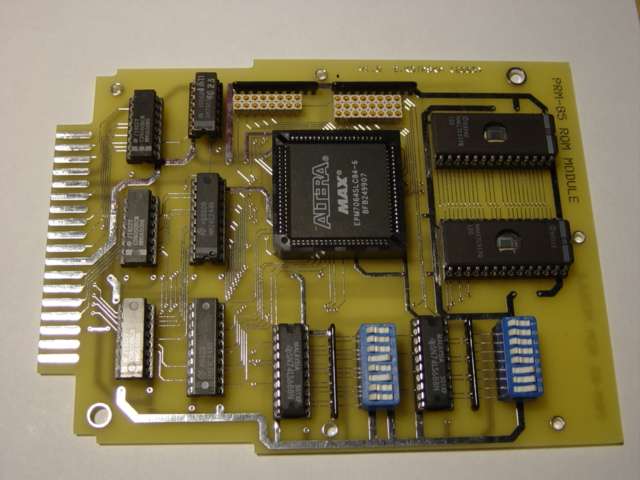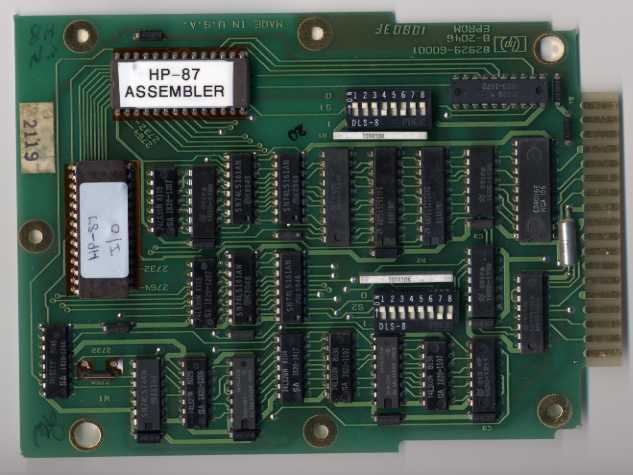HP Series 80 PRM-85
PRM-85 - Background
The following gives the background to the PRM-85 project. The board was developed by Bill Kotaska (USA), with support from John Shadbolt (UK).
There is a waiting list for new boards, please email me to enquire.
Bill has developed several other projects, please see his web page for details.
December 2017
Eighth batch of around 20 boards produced, and shipped to customers in US, Denmark and Germany.
December 2016
Seventh batch of around 12 boards produced, and shipped to customers in US, UK, France, Germany, Belgium, Italy and the Czech Republic.
February 2013
Sixth batch of around 12 boards produced, and shipped to customers in US, UK, France, Australia and Germany.
January 2011
Fifth batch of around 30 boards produced, and shipped to customers in US, Switzerland, Australia (including one customer who now has 9 boards), Belgium, Canada, Netherlands and Switzerland.
June 2009
Fourth mini-batch of 7 boards produced, and shipped to customers in US, Australia, France, Germany and Denmark.
February 2008
Existing HP-85 SuperROM found not to provide Extended Mass Storage support for HP-85A owners. Revised SuperROM v2 produced which fixed issue, by including HP-85B versions of Mass Storage and EDISK ROMs.
Third batch of 14 boards produced, and shipped to customers in US, UK, Australia, France, Spain, Germany and Switzerland.
September 2006
Second batch sold out, and shipped to customers in US, UK, France, Austria, Italy, Belgium, Germany and New Zealand.
August 2006
Bill makes second batch of boards (again around 10), including modifications such as decoupling capacitors and a change to the layout to avoid having to modify a Series 80 module case. Below is such a V1.1 board.

January 2006
First batch of production boards shipped to customers in US, France, Switzerland and Germany.
December 2005
Bill makes a 'production run' of around 10 PRM-85 boards.
24th October 2005
First PRM-85 (one of the four prototypes) sold to a customer in the UK.
18th September 2005
John checks PRM-85 out in HP-87, passes tests with 2764 EPROM versions of the Assembler and EMS ROMs.
11th September 2005
John fits PRM-85 into the case from a Series 80 HP-IB module (see casing instructions).
19th April 2005
John receives PRM-85 for first time, checks out OK on HP-85B.
28th February 2005
Bill ordered four PCBs as the production prototype, built one (as below) and tested OK. Offered to send one to John for evaluation.

3rd January 2005
Bill produced revised design using an Altera EPLD and several other chips. This included decoding for 8 of the most common ROMs inside the EPLD. Planning on including 2 dip switches for other ROM selections. Bill had prototype running using a 27512 "SuperROM" with 8 ROM images. The nice thing about the EPLD version is that it lets you have all ROMs active at the same time with no dip switches to set. Next step was to design a PCB for this circuit.
28th November 2004
Here is a picture of Bill's first prototype board:

Note
the ribbon cable from the prototype board was attached to a ROM socket in
a standard HP Rom Drawer. A couple of cuts and jumps were made in the ROM
drawer for signal routing (the other 5 ROM slots were unaltered.)
Bill thought it would be possible to expand the capabilities of the
original Programmable ROM module beyond just 2 simultaneous ROMS. Multiple
images could be stored on a bigger ROM and be available to the system via
addressing logic in the new module. This will be simplified through the
use
of an EPLD. Each image would still require dip switch selection
18th November 2004
Proposal agreed to use a large EPROM with multiple ROM images, and tie the address lines appropriately, so that one EPROM could be manually switched between several images, thus saving unplugging and plugging different EPROMs with a single ROM image.
Bill changed original design
by replacing the now defunct CD40116 with an HCMOS buffer (HC244) and 2
CMOS drivers (4050's) which are very common chips. He also ordered
some Altera PLDs to try to implement the logic using a minimal chip count.
10th November 2004
Bill's prototype now fully operational. Passed the XROM tests of the HP-85 Service ROM with no more checksum errors. Next step was to replace the CMOS/TTL translator chip (which was very hard to find) with standard parts. The other uncommon chips were replaced in the first cut at the circuit.
3rd November 2004
Bill wrote "Finally got it all wired up! Burned the Assembler and
Service ROM's to check it out. With the Assembler ROM installed by itself,
I get an ERROR 115 (checksum error). I am able to use the MEM command
however so some of the ROM is being accessed correctly. With both ROMs
installed, the Service program starts to execute after power-up and I can
run the various tests. The External ROM test fails on both the ASM and
Service ROMs. Long story short - at least some part of the ROMs are being
accessed, need to check for mis-wires or bad chips in the memory
addressing section."
August - September 2004
Bill started making up a prototype of the Programmable ROM module clone. John came across Bill's message and made contact. Bill asked John to ring-out with an ohmmeter the last few connections on the real Programmable ROM module, as they were hidden by components.
10th December 2003
Bill posts request for help in drawing up schematic of the HP Programmable ROM module, with aim of developing a clone.
September 2003
Vassilis Prevelakis posts message on classiccmp with pictures of top and bottom of HP Programmable ROM Module, to help others determine the circuit diagram.
June 2003
John scanned HP Programmable ROM module:

November 2002
The series 80.org site included further HP-85 ROM images on its site, plus images for the HP-87.
October 2002
John posted details of initial set of HP-85 ROMs to 1980s Vintage Computers site. Some interest from others in building a clone module.
September 2002
John bought two HP 82929A Programmable ROM modules. With help of HP-85
Assembler manual, downloaded ROMs to files and programmed some 2764 EPROMs, which
then acted as ROMs in the 82929A.
This page was last revised on: 30/12/17